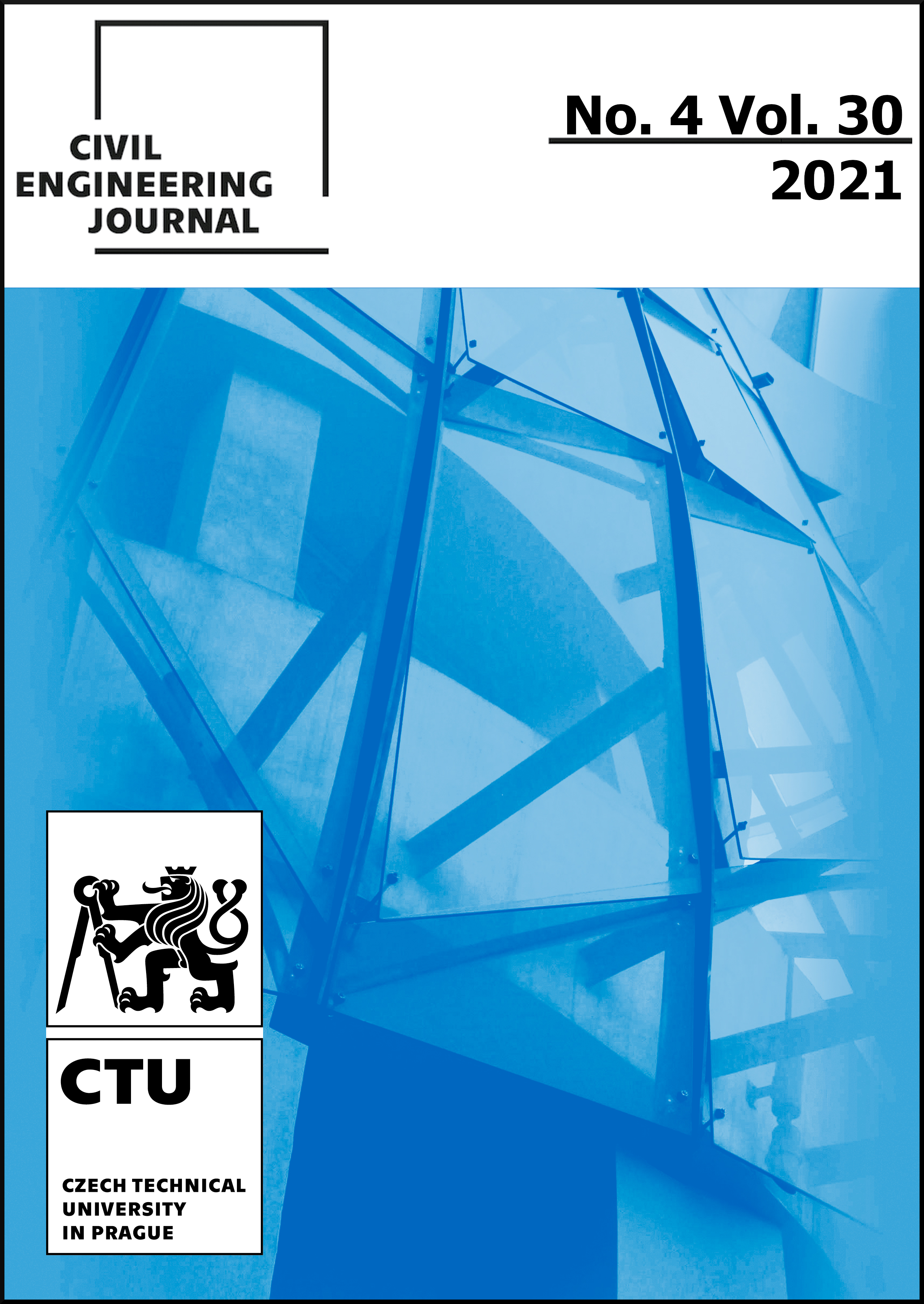FLEXURAL SIMULATION ANALYSIS OF RC T-GIRDERS STRENGTHED WITH POLYURETHANE CEMENT-PRESTRESSED STEEL WIRE ROPES
DOI:
https://doi.org/10.14311/CEJ.2021.04.0069Keywords:
Finite element analysis (FEA), Finite element modelling, T-girder strengthening, Polyurethane cement-prestressed steel wire ropesAbstract
To verify the effectiveness of polyurethane cement-prestressed steel wire ropes for flexural reinforcement of reinforced concrete T-girders, this paper conducts flexural test research on 12 pieces of T-girder specimens. Through the ABAQUS finite element program to build a model for numerical simulation, the results show polyurethane cement prestressed steel wire rope reinforcement can significantly increase the yield load and ultimate load of reinforced girders. Taking a girder in the test (20mm reinforcement thickness of polyurethane cement) as an example, yield load and ultimate load increased by 61.5% and 102.3% compared to unreinforced girder. The finite element model calculation results of T-girder bending reinforcement are in good agreement with the bending reinforcement test, and the error is only about 2%. For different strength concrete, the yield load increases slightly with the increase of concrete strength. For T-girders with different reinforcement ratios, the bearing capacity of strengthened girders changes significantly with the increase of longitudinal reinforcement ratio. The yield load of girders with reinforcement ratio of 1.82% and 1.35% is 29.84% and 65.85% higher than that of girders with reinforcement ratio of 0.91%. The yield deflection is 13.18% and 3.99% higher than that of girders with reinforcement ratio of 0.91%. It can be concluded that the bending reinforcement method of polyurethane cement prestressed steel wire ropes can effectively strengthen the main girder and ensure the structural safety.
Downloads
References
Zhou, Y. 2007. Practice and discuss of bridge disease measuring and punishing methods. Urban Roads Bridges & Flood Control.
Liu, G. J. 2008. The analysis of T-girder bridge diseases and reinforcement technology. Shanxi Architecture.
Ye, W., Ji, L., Highway, S. O., & University, C. 2014. Disease analysis and reinforcement method for a simply supported t-shaped girder bridge. Modern Transportation Technology.
Wang, Y. M. 2012. Analysis of maintenance and reinforcement about bridge pier and abutment. Transportation Standardization.
Fan, H. B. 2010. Inspection and maintenance & reinforcement of state-province artery bridge system. Enterprise Science and Technology & Development.
Chen, W. C., & Jian-Qin, M. A. 2006. Discussion on main diseases of the prestressed continuous rigid-frame bridge and its maintenance and reinforcement mornitoring. Communications Standardization.
Laane, A., & Lebet, J. P. 2005. Available rotation capacity of composite bridge plate girders under negative moment and shear. Journal of Constructional Steel Research, 61(3), 305-327.
RA Parmelee,RB Corotis. 2004. Analytical and experimental evaluation of existing florida dot bridges. finite element method.
Huang, S. N., Lu, X. Z., Zheng, J. C., & Zhu, W. 2012. Overload-induced progressive collapse simulation for a reinforced concrete arch bridge. Engineering Mechanics, 29(SUPPL. 2).
Ghoneim, G. , & Ghali, A. . 2011. Nonlinear analysis of concrete structures. Canadian Journal of Civil Engineering, 9(3), 489-501.
Dharaneepathy, M. V., & Anandavalli, N.. 2008. Nonlinear analysis of shock-loaded reinforced concrete structures. International Journal of Structural Stability & Dynamics, 4(02), 223-236.
Cao, M. 2012. Research on damage plastic calculation method of abaqus concrete damaged plasticity model. Transportation Standardization.
Yuan, M., Yuan, S., & Yan, D. H. 2008. Analysis on plastic damage of prestressed concrete box girder. Journal of Highway and Transportation Research and Development.
Zhang, H. X., & Lu-Yuan, H. E. 2014. Numerical simulation analysis on bond-slip behavior of concrete strengthened with near-surface mounted cfrp bars based on abaqus. Engineering Mechanics.
Chuan-Xue, X. U., & Liu, F. 2016. Analysis of the influence factors of long-term rigidity of girder by external prestressing. Jiangsu Construction.
Zhang, Z., & iu, Y. 2011. Concrete damaged plasticity model in abaqus. Building Structure.
China Academy of Building Research. 2016. GB50010-2010 Code for design of concrete structures. Beijing: China Architecture & Building Press.
Cao, M. 2012. Research on damage plastic calculation method of abaqus concrete damaged plasticity model. Transportation Standardization.
V Birtel ,P Mark. 2006. Parameterised finite element modelling of RC girder shear failure.
Yuan, M., Yuan, S., & Yan, D. H. Analysis on plastic damage of prestressed concrete box girder. Journal of Highway and Transportation Research and Development.
Zhang, K., & Sun, Q. 2018. Experimental study of reinforced concrete t-girders strengthened with a composite of prestressed steel wire ropes embedded in polyurethane cement (PSWR-PUC). International Journal of Civil Engineering,Transaction A:Civil Engineering, 16(9), 1109-1123.
Zhang, K., Qi, T., Zhu, Z., Xue, X., & Shen, X. 2021. Strengthening of a Reinforced Concrete Bridge with a Composite of Prestressed Steel Wire Ropes Embedded in Polyurethane Cement. Journal of Performance of Constructed Facilities, 35(5), 04021063.
Downloads
Published
Issue
Section
License
Copyright (c) 2021 Author

This work is licensed under a Creative Commons Attribution-NonCommercial 4.0 International License.
Authors who publish with this journal agree to the following terms:
- Authors retain copyright and grant the journal right of first publication with the work simultaneously licensed under a Creative Commons Attribution License that allows others to share the work with an acknowledgement of the work's authorship and initial publication in this journal.
- Authors are able to enter into separate, additional contractual arrangements for the non-exclusive distribution of the journal's published version of the work (e.g., post it to an institutional repository or publish it in a book), with an acknowledgement of its initial publication in this journal.
- Authors are permitted and encouraged to post their work online (e.g., in institutional repositories or on their website) prior to and during the submission process, as it can lead to productive exchanges, as well as earlier and greater citation of published work (See The Effect of Open Access).
How to Cite
Accepted 2021-11-03
Published 2021-12-31











